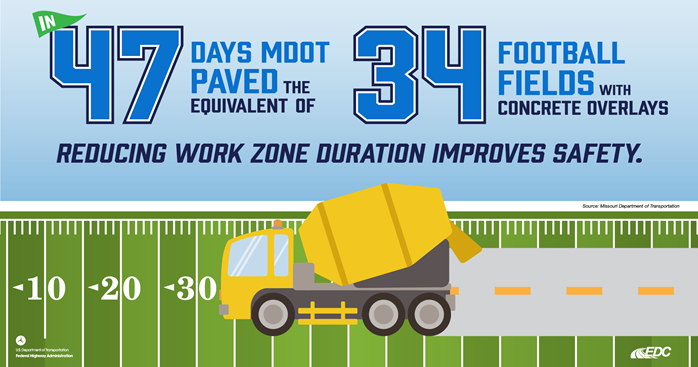August 4, 2022
Innovation of the Month: Next Generation Traffic Incident Management
Computer aided dispatch (CAD) systems are used by police and fire agencies to track calls from the public and document the activities of responders. CAD integration describes how public safety agencies share event data with transportation agencies. This makes traffic incident detection, response, and clearance activities timelier and more efficient, improving safety for responders and drivers. In Iowa, the Department of Transportation (DOT) saw an opportunity to promote CAD usage among public safety agencies, and consequently the sharing of data within the DOT. Similar to the way that Iowa crash reporting was improved by providing software to law enforcement, a low-cost CAD solution held the promise to help responder agencies improve incident response.
The Iowa DOT funded the development of the Mobile Architecture for Communications Handling (MACH), an internet-based communications tool that allows public safety agencies to share information, and enhance cooperation and organization during everyday activities and emergency situations.
MACH interfaces with state and national information systems to access wanted persons, driver license, and vehicle registration records. The messaging features in MACH have replaced the need for phone calls and radio conversations, thereby expediting information sharing with transportation agencies like traffic management centers (TMCs). MACH also shares a listing of all active events between agencies so that traffic managers gain visibility that was previously not present. TMC staff in Iowa now have an awareness of traffic incidents that enables traveler information system updates. TMC operators can also interface with dashboard tools that leverage roadway camera images to the benefit of all responders. Better information creates better response and CAD integration has proven to be an approach that benefits both public safety and transportation agencies.
The MACH program was initially developed and piloted in Iowa as part of the Traffic and Criminal Software (TraCS) solution that became a national standard for traffic crash reporting. Like the TraCS program, multiple state DOTs now license and share MACH with their respective law enforcement agencies.
To learn more about Next Generation TIM, please contact Paul Jodoin or James Austrich, FHWA Office of Operations.
Concrete Overlays in Missouri Save Time, Improve Safety
Concrete overlays can save significant amounts of time compared to traditional methods. The Missouri Department of Transportation (MoDOT) learned just how much when it needed to resurface a nine-mile stretch of I-44 near Rolla, Missouri, part of the main connector between the Lake of the Ozarks and St. Louis. With the Lake of the Ozarks being a major recreation and vacation destination, construction-related traffic delays were a major concern; therefore, the contract specified 90 calendar days for completion. Two miles of the project involved milling 11 inches of the existing asphalt pavement and inlaying an 11-inch concrete overlay. Seven miles of the project involved placing an 8-inch unbonded concrete overlay using a geotextile fabric as the separation layer. The contractor paved 219,137 square yards of concrete in 47 days and turned over the project to the State in only 66 days.
To learn more about concrete overlays, visit the FHWA TOPS website or watch a recent webinar called “Concrete Overlays: A Proven Technology.” Webinar topics include an introduction to concrete overlays, challenges, maintaining existing pavements, the value proposition, how to get started, and project highlights. For additional information, contact Robert Conway, FHWA Resource Center.

High Friction Surface Treatments Effectively Reduce Crashes
In 2012, Thurston County in Washington State conducted a data-driven safety analysis to identify and prioritize potential safety projects that would be eligible for Highway Safety Improvement Program (HSIP) funds. The data showed that 27 percent of fatal and severe crashes involved skidding or out of control vehicles. The data also revealed that wet and icy pavements contributed to 47 percent of crashes. These patterns led the County to identify high friction surface treatment (HFST) as an effective solution for crash reduction. The County used risk factors for arterial and collector roads to prioritize locations for HFST, including posted speed limit of 50 mph or more, traffic volumes, presence of horizontal curves, and shoulder type and width.
In 2016, the Washington State Department of Transportation awarded Thurston County more than $2 million for HFST at 29 locations, which were installed in 2018. In the three years following installation, the HFST projects at horizontal curves have resulted in substantial reductions in average crashes per year, including 46 percent for total lane departure crashes, 70 percent for wet lane departure crashes, and 100 percent for fatal and serious injury lane departure crashes.
To learn more about reducing rural roadway departures in your State, please contact Cate Satterfield with the FHWA Office of Safety or Dick Albin with the FHWA Resource Center.
Stay Up to Date on the EDC Innovations That Interest You Most

EDC teams are always on the move! If you blink, you could miss out on important webinars, case studies, tools, videos, and more. To never miss information for the EDC innovations that interest you most, visit the subscription page and select the topics you’d like to receive updates on directly from the teams that coordinate them.
Recent bulletins:
TOPS 7/25/2022
Local Aid Support 8/2/22
About EDC
Every Day Counts, a state-based initiative of the Federal Highway Administration's Center for Accelerating Innovation, works with state, local and private sector partners to encourage the adoption of proven technologies and innovations to shorten and enhance project delivery.
EDC News is published weekly by the FHWA Center for Accelerating Innovation.
Notice: The U.S. Government does not endorse products or manufacturers. Trademarks or manufacturers’ names appear in this presentation only because they are considered essential to the objective of the presentation. They are included for informational purposes only and are not intended to reflect a preference, approval, or endorsement of any one product or entity.
Recommended Citation:
U.S. Department of Transportation, Federal Highway Administration
EDC News; August 4, 2022
Washington, DC
https://doi.org/10.21949/1521847


